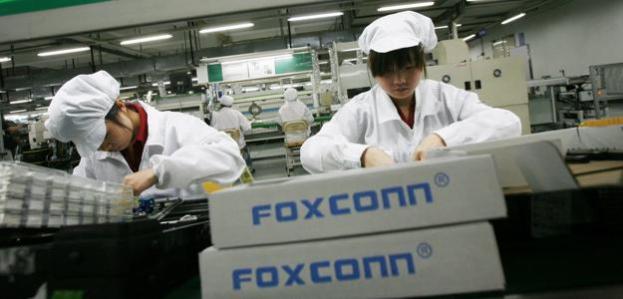 Electronics manufacturing giant Foxconn posted record quarterly profits on Monday, with the healthy figures attributed largely to improved efficiency and increased output of Apple’s iPhone 5 and iPad 4 devices.
Electronics manufacturing giant Foxconn posted record quarterly profits on Monday, with the healthy figures attributed largely to improved efficiency and increased output of Apple’s iPhone 5 and iPad 4 devices.
Hon Hai Precision Industry, better known as Foxconn, saw its Q4 revenue – covering the October to December 2012 period – increase 6 percent on a year ago to TWD$1.14 trillion ($38 bn), while net income went up 5.6 percent on a year ago to a record TWD$37 billion ($1.2 bn), Bloomberg reported Monday.
Full-year net income for 2012 rose 16 percent to TWD$94.8 billion ($3.2 bn) from TWD$81.6 billion ($2.7 bn) in 2011, while revenue increased 13 percent to a record TWD$3.9 trillion ($130 bn).
The company, which employs over a million people and operates the majority of its factories in China, is the world’s biggest manufacturer of electronic goods, with Apple, Sony, Google, Dell, Nintendo and Amazon among its clients.
The Cupertino company is one of its biggest customers, with sales of Apple devices helping to push Foxconn’s income to record levels. The US tech titan sold 47.8 million iPhones from October to December, an increase of 10 million units on a year earlier, with the launch of the iPhone 5 helping to boost sales. The iPad Mini also launched towards the end of last year, helping tablet sales to increase markedly in Q4 compared to 12 months earlier.
If Apple wins, Foxconn wins, though some believe a drop in sales is in the pipeline as demand for Apple’s latest phone begins to relax with would-be iPhone buyers holding off in anticipation of the next iteration of the handset. Increased competition from rivals such as Samsung with its recently launched Galaxy S4 device could also play its part.
Foxconn evidently resolved earlier issues concerning the manufacture of the iPhone 5, which hit stores in September last year. With mounting orders for the phone pushing the company to the limit, Foxconn boss Terry Gou admitted last November his company was falling short of meeting demand.
A Foxconn official called it “the most difficult device that Foxconn has ever assembled,” mainly because of its lighter, thinner design, which calls for more precision from factory workers when putting the handset together.
“It takes time to learn how to make this new device. Practice makes perfect. Our productivity has been improving day by day,” the official said at the time.


